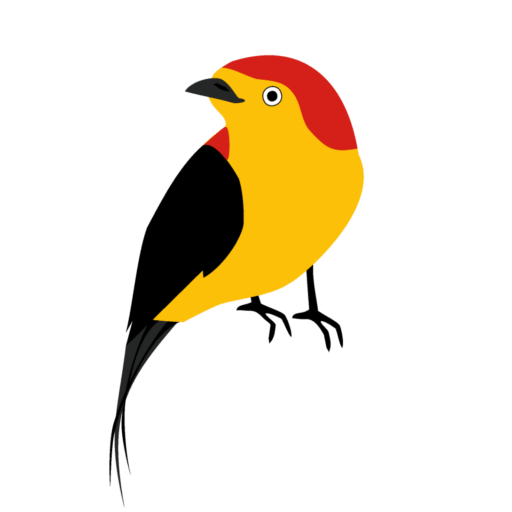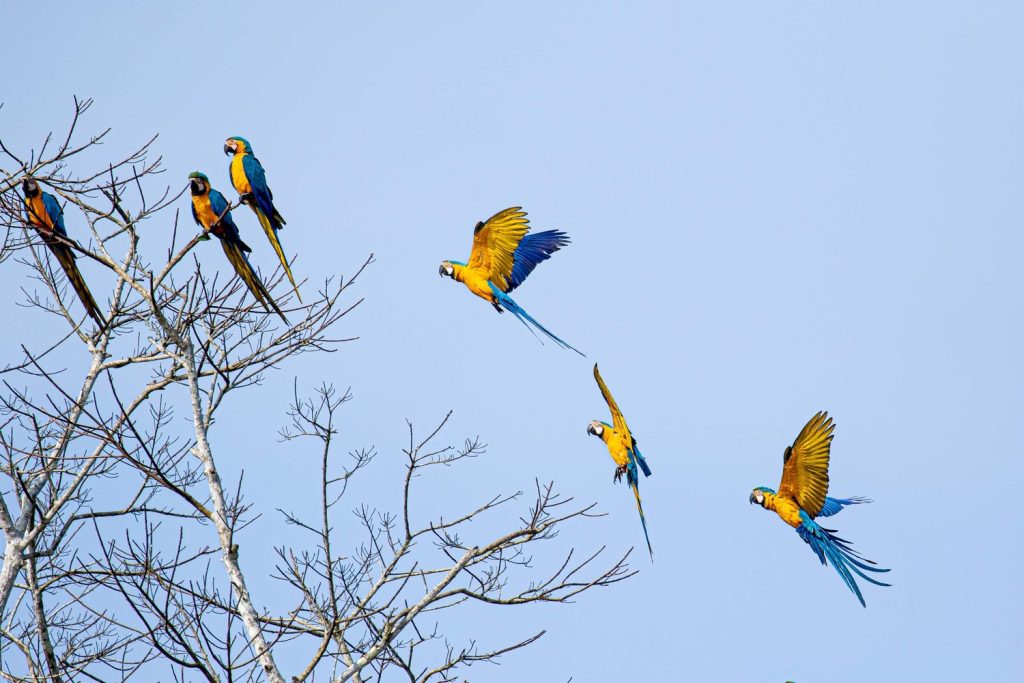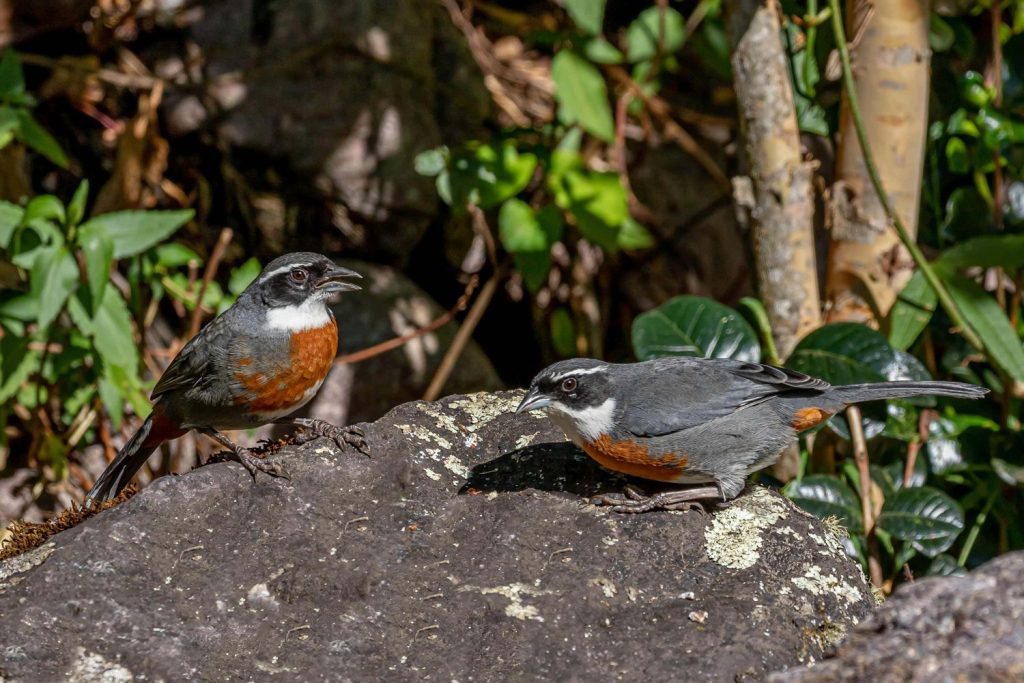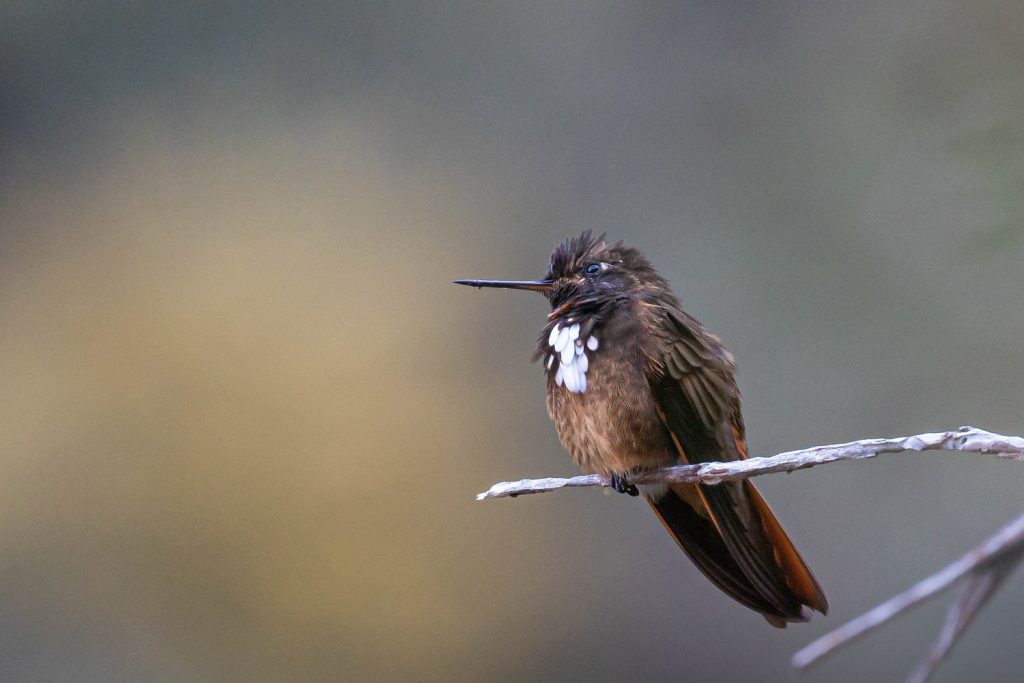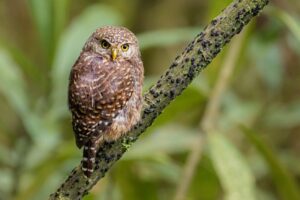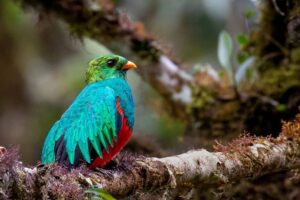The cloud-wreathed heights of the Peruvian Andes, a realm where earth meets sky, are home to an astonishing array of life. Among these creatures, the Woodcreepers command a special interest from the professional birdwatching community. Identifying Woodcreepers is a must here, they belong to the Dendrocolaptidae family, embody the essence of avian adaptation and survival in the dense Andean forests. Their adept camouflage and secretive nature make them a challenging yet rewarding find for any birdwatcher.
Woodcreepers serve as a vital component of the Andean ecosystem, contributing significantly to the biological control of insect populations and thus maintaining the health of their woodland habitats. Their presence is an indicator of forest health and biodiversity. Yet, despite their ecological importance, Woodcreepers remain one of the most challenging groups for ornithologists and birdwatchers to identify accurately. The combination of their elusive behavior, the dense habitats they prefer, and their morphological similarities poses a substantial obstacle, turning every sighting into a puzzle waiting to be solved.
This article aims to shed light on these masters of disguise, offering insights into the diversity and identifying Woodcreepers in Peru, their distribution across the Andean landscape, and providing a closer look at their genera. Most importantly, it seeks to equip professional birdwatchers with the knowledge and tools needed for accurate field identification. As we delve into the world of Woodcreepers, let us embark on a journey of discovery, where every feather, call, and movement brings us closer to understanding these fascinating creatures.
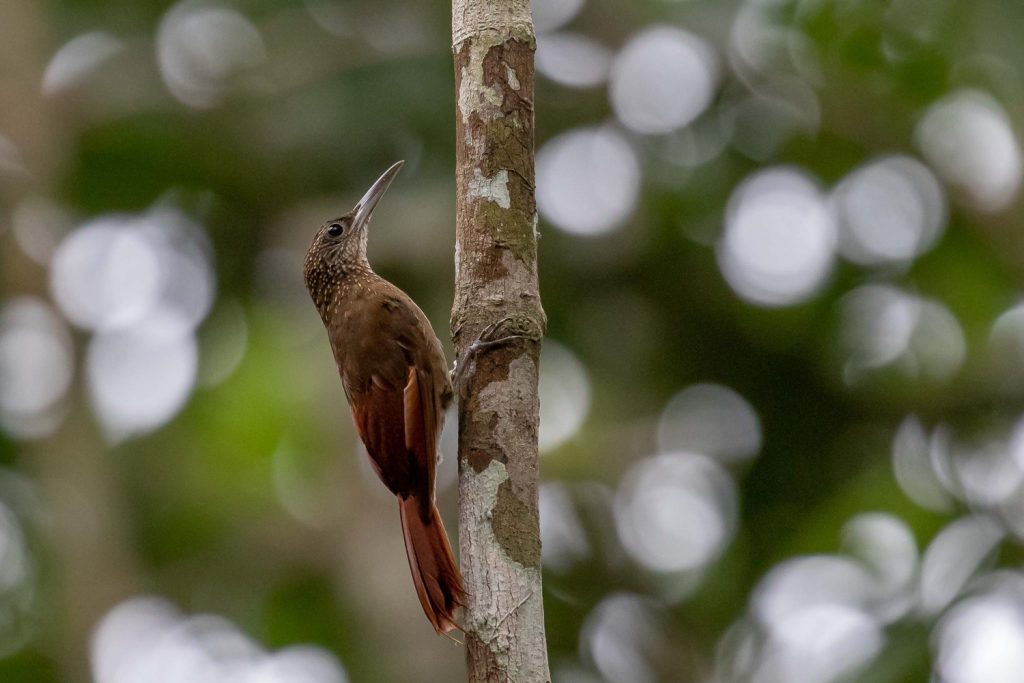
Diversity of Woodcreepers in Peru
In the intricate tapestry of Peruvian biodiversity, Woodcreepers stand out for their evolutionary adaptability and ecological variety. The Andean regions of Peru, with their unique environmental gradients, host an impressive diversity of Woodcreeper species. At least 10 species in Peru are inhabit the Andean ecosystem, each adapted to varying altitudes and ecological niches.
Its important to lern some species as bench marks for identifying Woodcreepers. Some of the key species that captivate the attention of birdwatchers include the Montane Woodcreeper (Lepidocolaptes lacrymiger), a species often observed in the cloud forests between 2000 and 3400 meters. The Strong-billed Woodcreeper (Xiphocolaptes promeropirhynchus), with its distinctive robust bill, is another species that thrives in the dense montane forests of the Andes. These species, among others, illustrate the rich tapestry of Woodcreeper life that adorns the Peruvian highlands.
The genera Xiphorhynchus, Lepidocolaptes, and Dendrocincla are particularly well-represented in the Andes. Xiphorhynchus, known for species like the Ocellated Woodcreeper, exhibits remarkable adaptability across different altitudinal ranges. Lepidocolaptes, including the aforementioned Montane Woodcreeper, is distinguished by its members’ slender builds and affinity for higher elevations. Dendrocincla, though less common, adds to the ecological and visual diversity of Andean Woodcreepers with species such as the Plain-winged Woodcreeper.
The Andean region’s varied topography and climate create a mosaic of habitats, each harboring specific Woodcreeper species. This altitudinal zonation means that birdwatchers can encounter different species as they ascend from the lush, tropical foothills to the mist-enshrouded cloud forests.
Understanding these patterns of distribution is crucial for the professional birdwatcher. Recognizing the habitat preferences and altitudinal ranges of different Woodcreeper species enhances the likelihood of successful identification and appreciation of the rich avian diversity present in the Peruvian Andes.
Genera Overview for dentifying Woodcreepers
The Andean landscapes of Peru are not just a backdrop for the diverse tapestry of Woodcreeper species; they are integral to the narrative of each bird’s evolutionary journey. Among the genera that have carved out their niche within these cloud-swathed heights, three stand out for their prevalence and the identification challenges they pose to birdwatchers: Xiphorhynchus, Lepidocolaptes, and Dendrocincla.
Xiphorhynchus is perhaps the most recognizable genus, with species like the Ocellated Woodcreeper. These birds are characterized by their streaked plumages and robust bodies, adapted for a life spent scaling the trunks of towering Andean trees. Their calls, a series of sharp, distinctive notes, echo through the forests they inhabit, serving as a beacon for birdwatchers.
Lepidocolaptes, including the slender Montane Woodcreeper, is renowned for its members’ long, narrow bills and agile climbing techniques. These traits enable them to extract insects from crevices in the bark with remarkable efficiency. The genus showcases a variety of adaptations that underline the evolutionary creativity of nature.
Dendrocincla, though less commonly encountered, adds a layer of diversity with species such as the Plain-winged Woodcreeper. These birds often forage in mixed-species flocks, blending seamlessly into the complex ecosystem of the Andean forests.
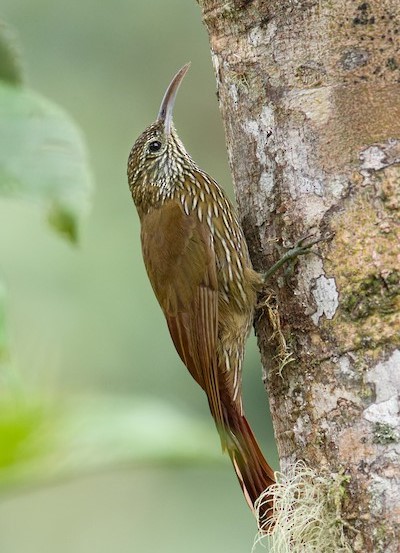
Montane Woodcreeper
Identifying Woodcreepers, Challenges and Tips
Identifying Woodcreepers in the field is akin to solving a complex puzzle. Their similar size, shape, and often cryptic plumage patterns can confound even the most experienced birdwatchers. However, understanding certain key characteristics can turn these challenges into a rewarding endeavor.
Visual Markers: Paying close attention to plumage patterns, such as streaking or barring, and the presence of distinctive marks can be crucial. The size and shape of the bill are also significant, as these vary between species and are adapted to their feeding habits.
Vocalization Patterns: Woodcreepers are vocal birds, and their calls often provide the best clue to their identity. Learning the specific calls and songs of different species can greatly enhance field identification.
Behavioral Cues: Observing how a bird forages—whether it moves up, down, or around tree trunks—can offer insights into its species. Some Woodcreepers participate in mixed-species flocks, which can also inform their identification.
Habitat Preference: Knowing the preferred habitat of species, such as elevation range and forest type, can help narrow down the possibilities before even spotting the bird.
Armed with these tips and a keen sense of observation, birdwatchers can navigate the challenges of identifying Woodcreepers in the Peruvian Andes. It’s a journey that requires patience and persistence, but the rewards—uncovering the hidden lives of these fascinating birds—are immeasurable.
Guide to the most common Andean Woodcreepers
- Montane Woodcreeper (Lepidocolaptes lacrymiger)
- Habitat: Prefers cloud forests; found at altitudes of 2000 to 3400 meters. Adaptable to secondary forests and forest edges.
- Behavior: Agile climbers, often seen alone or in pairs moving with Mixed species flocks, methodically inspecting bark and moss for insects.
- Field Marks: Medium size, brownish overallwith rufous wings and tail. Notable for its slender and very decurved bill; characterized by streakes on breast (streaked, not mottled!).
- Olive-backed Woodcreeper (Xiphorhynchus triangularis)
- Habitat: Ever green cloud forests; found at altitudes of 1000-2000 meters. Found regularly in mature forest interior but very adaptable to secondary forests and edges.
- Behavior: Seen frequently in pairs acompanying mixed flocks.
- Field Marks: Mottled on underparts (not streaked) Brownish-olive overall. Notable for its slender bill and eyering and eyebrow. characterized by streaked brown plumage and a buffy throat, making it distinctive among its habitat’s lush greenery.
- Strong-billed Woodcreeper (Xiphocolaptes promeropirhynchus)
- Habitat: Inhabits dense montane forests, especially areas with thick undergrowth. Ranges from 1500 to 3000 meters in elevation. This species is by far the most widespread with an amazing 25 subspecies described along its range.
- Behavior: Known for its robust foraging technique, often dislodging large bark pieces in search of prey. It’s more often heard than seen, due to its deep, resonant calls. Frequently join mixed species flocks of larger birds such as jays and orioles foraging on crevices and large bromelias.
- Field Marks: Its a large woodcreeper with it´s notable strong bill as a key identifier. Streaked brown plumage and a more rufous tail, distinguishing it from other species.
- Ocellated Woodcreeper (Xiphorhynchus ocellatus)
- Habitat: Found in every green forest on Andean slopes and foothills. Shows preference for mature forest but may visit edges and succecional habitats. It occurs in the lowlands but reaches close to 2000 meters.
- Behavior: Frequents mixed-species flocks, moving quickly through foliage for insects. Visits crevices, palm fronds and dead leaves Very dominant over other species.
- Field Marks: Decurved and long bill. Brownish with buffy tear-shaped streakes (not really ocelated!) on head, throat, back and breast but all marks are very variable. Voice is the most reliable way for identification.
- Wedge-billed Woodcreeper (Glyphorynchus spirurus)
- Habitat: It mainly occupies amazon lowlands but it´s seen frequently on the west slopes of the Andes up to 1500 meters.
- Behavior: Common bird in the lowlands, uncommon at the cloud forest. This species is a diligent forager, often seen scaling tree trunks and large branches in a spiral pattern searching for little aracnids and insects, joining mixed flocks.
- Field Marks: One of the easier species to identify, very small , it´s short upturned bill and small size resembles a Xenops more than a Woodcreeper but notice long tail and spiky rectrices. Lores are buffy and a has a light superciliar.
- Tyrannine Woodcreeper (Dendrocicla tyrannina)
- Habitat: Found in humid forest in cloud forest where prefers forest interior but may be seen in edges and dislike clearings. Regularly at higher elevation than most of other woodcreepers 1500 – up to 3000 meters.
- Behavior: Rarely participates in mixed-species flocks and normally found alone. Although it forages low it´s very elusive and evasive. Seems to like slender trunks instead of the ones with bromelias. Its versatility in foraging, utilizing a mix of bark peeling and probing in crevices.
- Field Marks: Large and heavy and a long and thick bill curved in the end. Features a buff brown uniform body, lighter throat and rufescent wings and tail. Very lightly marked on thorat and upper chest.
- Red-billed Scythebill(Campylorhamphus trochilirostris )
- Habitat: Thrives in a variety of forest types, from tropical lowlands to subtropical montane forests, up to about 1500 meters.
- Behavior: Often participates in mixed-species flocks. Known for its versatility in foraging, utilizing a mix of bark peeling and probing in crevices.
- Field Marks: Slim and very distinctive woodcreeper of west slopes of andes and lowlads in bamboo. Features fine streakes on face, neck and upper chest and rufous-olive plumage . Red, thin, decurved and long bill is distinctive body.
- Greater Scythebill (Drymotoxeres pucheranii)
- Habitat: Very few is known about this bird, Apparently exist in cloudforest and elfin forest. It may forage at forest edges at high elevations 2000-3000 meters.
- Behavior: Poorly known and rare, seems to forage with large mixed flocks low at eye level at branches covered with moss.
- Field Marks: Large woodcreepers with a great but thin bill (Cf. Strong-billed Woodcreper in size) Even brown plumage with a face framed by light malar and superciliar and brown auriculars. Unmistakable.
Each of these species presents a unique combination of behaviors and physical characteristics that, when noted carefully, can greatly aid in their identification. Understanding these nuances is essential for any birdwatcher aiming to navigate the challenging yet rewarding endeavor of spotting Woodcreepers in the Peruvian Andes. If you are interested in Birding in the high Andes, you will find an exquisite selection of tours here.
Conservation Efforts
In response to these challenges, conservation organizations, both local and international, have launched initiatives aimed at protecting Woodcreepers and their habitats. Projects such as the Andean Forest Conservation Program focus on reforestation, sustainable agriculture practices, and the establishment of protected areas. Additionally, citizen science projects, like the Peruvian Bird Monitoring Network, encourage birdwatchers to contribute sightings and data, playing a vital role in tracking species distributions and informing conservation strategies.
The plight of the Andean Woodcreepers underscores the interconnectedness of biodiversity, ecosystem health, and human activity. As these studies and efforts highlight, safeguarding the future of these species requires a concerted, multidisciplinary approach that bridges scientific research, conservation action, and community involvement.
Written by Danny Vargas by Manakin Expeditions

